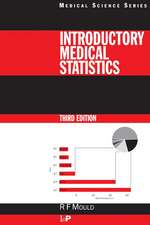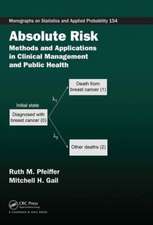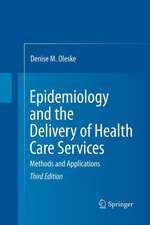Dose Finding by the Continual Reassessment Method: Chapman & Hall/CRC Biostatistics Series
Autor Ying Kuen Cheungen Limba Engleză Hardback – 29 mar 2011
A self-contained theoretical framework of the CRM for researchers and graduate students who set out to learn and do research in the CRM and dose-finding methods in general, Dose Finding by the Continual Reassessment Method features:
- Real clinical trial examples that illustrate the methods and techniques throughout the book
- Detailed calibration techniques that enable biostatisticians to design a CRM in timely manner
- Limitations of the CRM are outlined to aid in correct use of method
The author recognizes clinicians’ skepticism of model-based designs, and addresses their concerns that the time, professional, and computational resources necessary for accurate model-based designs can be major bottlenecks to the widespread use of appropriate dose-finding methods in phase I practice. The theoretically- and empirically-based methods in Dose Finding by the Continual Reassessment Method will lessen the statistician’s burden and encourage the continuing development and implementation of model-based dose-finding methods.
Din seria Chapman & Hall/CRC Biostatistics Series
-
 Preț: 386.62 lei
Preț: 386.62 lei - 5%
 Preț: 338.17 lei
Preț: 338.17 lei - 5%
 Preț: 656.94 lei
Preț: 656.94 lei -
 Preț: 341.42 lei
Preț: 341.42 lei -
 Preț: 355.91 lei
Preț: 355.91 lei - 8%
 Preț: 432.15 lei
Preț: 432.15 lei -
 Preț: 354.77 lei
Preț: 354.77 lei -
 Preț: 342.89 lei
Preț: 342.89 lei -
 Preț: 288.80 lei
Preț: 288.80 lei -
 Preț: 312.36 lei
Preț: 312.36 lei - 9%
 Preț: 644.57 lei
Preț: 644.57 lei - 8%
 Preț: 376.64 lei
Preț: 376.64 lei -
 Preț: 372.30 lei
Preț: 372.30 lei -
 Preț: 356.63 lei
Preț: 356.63 lei - 8%
 Preț: 531.50 lei
Preț: 531.50 lei - 9%
 Preț: 608.32 lei
Preț: 608.32 lei - 9%
 Preț: 766.27 lei
Preț: 766.27 lei -
 Preț: 378.11 lei
Preț: 378.11 lei -
 Preț: 356.63 lei
Preț: 356.63 lei - 9%
 Preț: 682.93 lei
Preț: 682.93 lei - 9%
 Preț: 594.78 lei
Preț: 594.78 lei -
 Preț: 311.47 lei
Preț: 311.47 lei -
 Preț: 362.08 lei
Preț: 362.08 lei - 9%
 Preț: 833.72 lei
Preț: 833.72 lei - 9%
 Preț: 683.11 lei
Preț: 683.11 lei - 9%
 Preț: 681.82 lei
Preț: 681.82 lei -
 Preț: 362.00 lei
Preț: 362.00 lei - 9%
 Preț: 940.38 lei
Preț: 940.38 lei - 18%
 Preț: 791.14 lei
Preț: 791.14 lei - 18%
 Preț: 702.37 lei
Preț: 702.37 lei - 18%
 Preț: 1730.31 lei
Preț: 1730.31 lei - 18%
 Preț: 786.89 lei
Preț: 786.89 lei - 25%
 Preț: 825.63 lei
Preț: 825.63 lei - 15%
 Preț: 678.14 lei
Preț: 678.14 lei - 25%
 Preț: 557.58 lei
Preț: 557.58 lei - 29%
 Preț: 625.83 lei
Preț: 625.83 lei - 18%
 Preț: 786.38 lei
Preț: 786.38 lei - 25%
 Preț: 778.07 lei
Preț: 778.07 lei - 25%
 Preț: 628.29 lei
Preț: 628.29 lei - 18%
 Preț: 1124.97 lei
Preț: 1124.97 lei - 28%
 Preț: 881.75 lei
Preț: 881.75 lei - 25%
 Preț: 526.81 lei
Preț: 526.81 lei - 18%
 Preț: 797.46 lei
Preț: 797.46 lei - 15%
 Preț: 479.86 lei
Preț: 479.86 lei - 18%
 Preț: 1017.63 lei
Preț: 1017.63 lei
Preț: 875.16 lei
Preț vechi: 1215.56 lei
-28% Nou
Puncte Express: 1313
Preț estimativ în valută:
167.46€ • 175.31$ • 138.56£
167.46€ • 175.31$ • 138.56£
Carte tipărită la comandă
Livrare economică 07-21 aprilie
Preluare comenzi: 021 569.72.76
Specificații
ISBN-13: 9781420091519
ISBN-10: 1420091514
Pagini: 205
Ilustrații: 29 b/w images, 40 tables and N/A CR Book
Dimensiuni: 156 x 234 x 15 mm
Greutate: 0.43 kg
Ediția:New.
Editura: CRC Press
Colecția Chapman and Hall/CRC
Seria Chapman & Hall/CRC Biostatistics Series
ISBN-10: 1420091514
Pagini: 205
Ilustrații: 29 b/w images, 40 tables and N/A CR Book
Dimensiuni: 156 x 234 x 15 mm
Greutate: 0.43 kg
Ediția:New.
Editura: CRC Press
Colecția Chapman and Hall/CRC
Seria Chapman & Hall/CRC Biostatistics Series
Public țintă
ProfessionalCuprins
Fundamentals. Design Calibration. CRM and Beyond.
Recenzii
"Overall, this book comprises a detailed and very useful description of a relatively ‘novel’ and advanced method for designing dose-finding trials, which is starting to draw attention in the medical statistics community. The book focuses on the design (not analysis) of phase I and phase II dose-finding trials using the continual reassessment method (CRM) and its variants. The method is introduced alongside a description of the R package dfcrm, aiming to provide the reader with the skills to implement the method in R. ...This book aims to be a ‘how-to book’ and although it seems to require only college algebra and basic calculus concepts, I did find it very technically advanced in terms of mathematical formulations and theories. However, it was also very thorough, containing plenty of practical examples and illustrations (and corresponding implementations in R), which helps its readability. Moreover, given the complexity behind the CRM design, it is difficult to imagine how it could be presented in a simplified manner and still satisfy the need for a deep understanding of the subject."
-Rute Vieira, ISCB 2018
-Rute Vieira, ISCB 2018
Descriere
This book presents the continual reassessment method (CRM) as a tool for dose-finding studies. With a focus on the implementation and practice of the CRM and its variations, it explains how the CRM may be calibrated and extended to suit common clinical settings. The book includes examples of real clinical trials data to illustrate the calibration techniques and shows how R can be used to carry out the techniques. It reviews the literature, related methodology, and theoretical properties of the CRM. It also explores alternatives for situations where the CRM fails.












